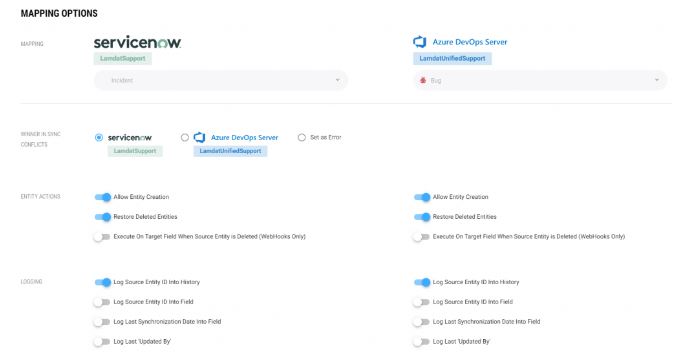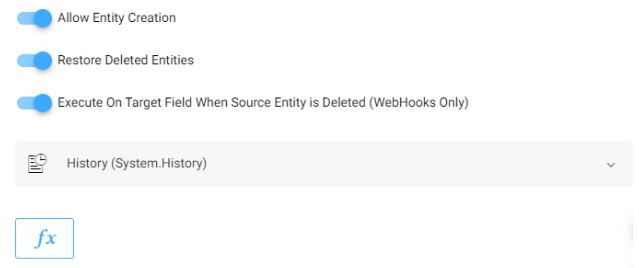Entity Mapping Options
Every entity pair in SyncNow has customizable mapping options.
Entity mapping options in SyncNow allow operators to define specific behaviors and rules for synchronizing entities between different systems. These options provide fine-grained control over how entities are created, updated, and managed during synchronization.
📝 Available Mapping Options
1️⃣ Creation of Entities in Target System
- Enable Creation: Allows the creation of new entities in the target system if they do not already exist. This ensures that all necessary entities are replicated across both systems.
2️⃣ Restoration of Deleted Entities in Target System
- Enable Restoration: Permits the restoration of entities that have been deleted in the target system. This option helps maintain consistency by ensuring that deletions can be reversed if needed.
3️⃣ Conflict Resolution
- Conflict Resolution Strategy: Determines which system's data takes precedence when conflicts occur. This setting is crucial for ensuring data consistency and integrity during synchronization.
- Options include prioritizing the source system, target system, or using a custom conflict resolution strategy.
4️⃣ WebHooks Continuous Synchronization
- Action on Deletion: For systems using continuous synchronization via WebHooks, this option allows you to define actions that should be taken in the target system when an entity is deleted in the source system.
- Actions can include updating specific fields, triggering workflows, or executing custom scripts.
5️⃣ Logging Sync Information in Target System
- Sync Logging: Enables logging of synchronization details in the target system. This can include:
- Who last updated the entity in the source system.
- The source entity ID, which can be logged into an ID field or a history/comments field.
- The last synchronization timestamp.
6️⃣ Entity Filtering
- Filter Entities: Allows the application of filters to determine which entities should be included or excluded from synchronization. This can be based on specific criteria such as entity type, status, or other attributes.
🔍 Detailed Features
🗒️ Logging Sync Information in Target System
Logging synchronization details in the target system helps track changes and maintain a comprehensive audit trail. SyncNow can log the following details:
- Last Updated By: Logs the user who last updated the entity in the source system.
- Source ID Logging: Logs the source entity ID into a designated field or a history/comments field in the target system.
- Last Synchronization Timestamp: Records when the entity was last synchronized, helping track the freshness of data.
🧩 Execute an Action on Deletion
This feature, available for system adapters using continuous synchronization, allows actions to be defined and executed when an entity is deleted in the source system. Actions can include:
- Field Update on Deletion: Select a target field to update when an entity is deleted in the source system.
- Custom Scripts or Plugins: Use C# scripts or plugins to execute specific actions. This can include custom logic for handling deletions or triggering additional processes.
Tip:
Use these mapping options to tailor synchronization behavior to your organization's needs, ensuring data integrity, auditability, and flexibility across all connected systems.

